I recently spent a night at the beautiful Secrets on the Lake in Queensland, Australia with my partner, Chontele. We stayed in a secluded lodge nestled amongst the dense rainforest.
I used this trip as a chance to test out some of my new plein air painting equipment. But, despite the stunning nature which surrounded us at Secrets, it was surprisingly difficult to find a subject to paint.
I was confronted with an unthinkable number of colors, shapes, lines, shadows, and highlights which made up the dense nature. Since I was painting on location, it was not an option to do a grand and detailed forest painting, much like Ivan Shishan’s painting below:

I needed to try and simplify all the “noise” down to something more concise that I could paint within a relatively short period. To add to the challenge, I needed to deal with changes in light and the environment.
After exploring the lodge and surrounding areas, I narrowed down on this location from an area on the balcony:

Some of the aspects which interested me were:
- The lake and mountain which you can see through the trees in the distance.
- The repetition of the tall tree trunks.
- The dappled light hitting the trees.
Plus the added convenience of being able to paint from the balcony.
However, as a whole, this scene was still far too complex to paint on location. The most likely outcome would have been a mess of color and one frustrated artist.
The solution was to crop out much of the detail and narrow it down to an area that captures the essence of the scene clearly and concisely. Below is what I came up with:

Notice how, even though I have cropped out most of the “noise”, this cropped version still captures the fundamental essence of the scene:
- You can still see the lake and the mountain through the trees. If anything, they appear more prominent in this cropped version.
- You still get a sense of repetition from the tall tree trunks.
- You can still see dappled light hitting the trees. Again, it seems to play an even stronger role in this cropped version.
To me, this is what simplifying a complex scene is all about-narrowing down on the essence of the scene and cutting out the rest. Much like a great writer uses fewer words to say more, whilst amateur writers try to overwhelm you with words.
Below are some more photos from the trip, starting with a photo of the blank canvas before I started painting. It was just after sunrise and fog filled the air; I could not even see through the trees to the lake or mountain the distance. But I assumed that by the time I had done a brief sketch, the fog would have cleared.

By the time the fog cleared, I was ready to start blocking-in some of the basic color shapes.
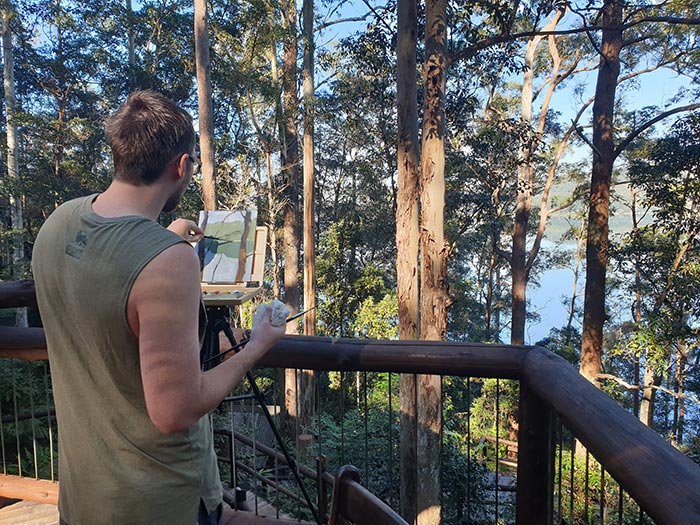
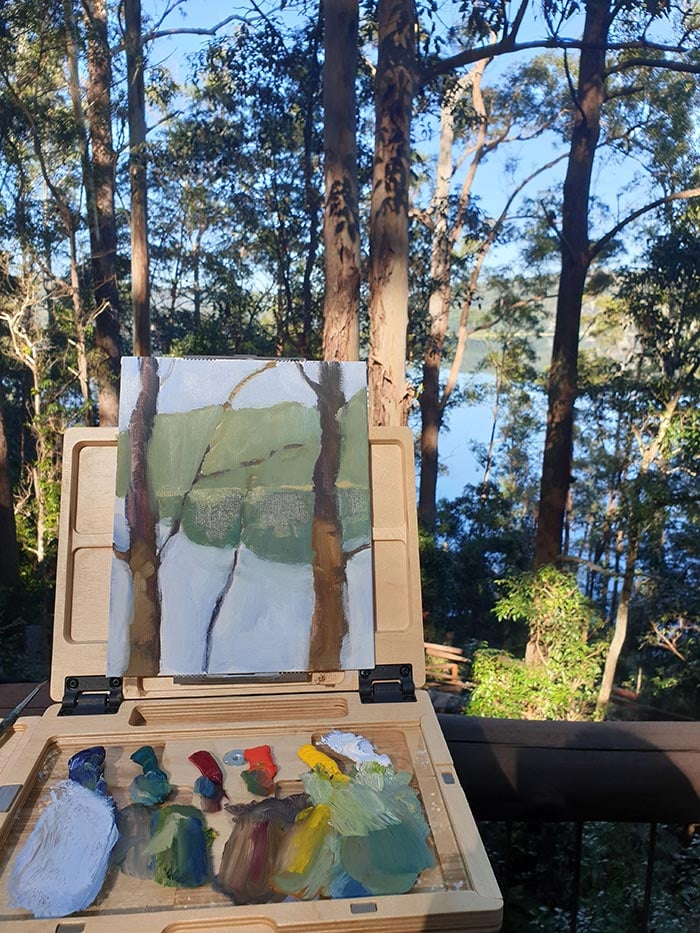
I had to work quickly, as the light was constantly changing. Towards the end of the painting, I needed to start working from memory because the shadows and colors had changed so significantly.
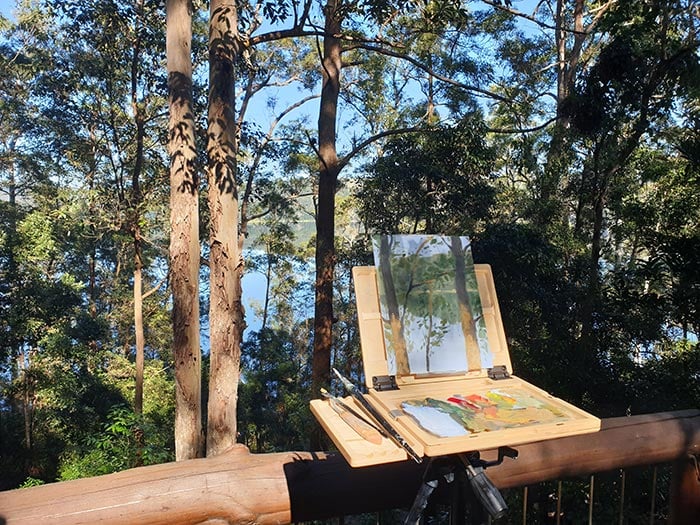
The end result is a rough study and a beautiful way to remember the trip. That is one of the key benefits of painting; you get a chance to document your life in a truly personal and creative way. Photos a great, but painting gives you a chance to capture how you see the scene.
Tip: The idea with these quick-studies done on location is not to capture a finely rendered version of what you are seeing. You only have time to capture the basics. But you can then use these studies along with photos to create a more detailed version back in the studio.

(Before diving into this post, make sure to pick up a copy of my free Landscape Painting Starter Kit.)
Composition Exercise
Next time you are surrounded by dense nature or some other complex scene, see if you can simplify the “noise” down to a clear and concise subject to paint. This is a great exercise in composition which will help you see like an artist.
General Tips for Simplifying the Complex
- Try to see in terms of the visual elements, being color, shape, line, etc. This will help you see the beauty in an otherwise bland area.
- Look for dramatic contrasts, such as light against dark, saturated against dull or rigid against organic.
- Try to narrow down on the essence of the scene by cutting out most of the “noise”.
- Use your hands to frame potential compositions.
- Be open-minded. On first glance, a scene might not look much, but further investigation might reveal, for example, a beautiful design created by the shadows.
Thanks for Reading!
Thanks for taking the time to read this post. I appreciate it! Feel free to share with friends. If you want more painting tips, check out my Painting Academy course.
Happy painting!
Dan Scott
Draw Paint Academy

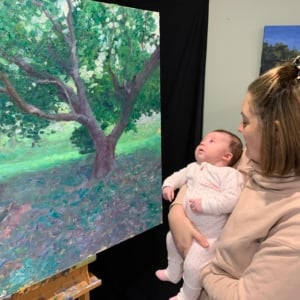


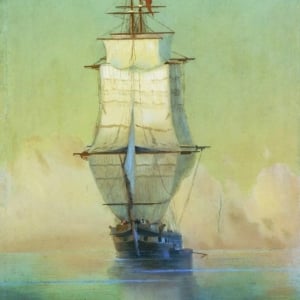
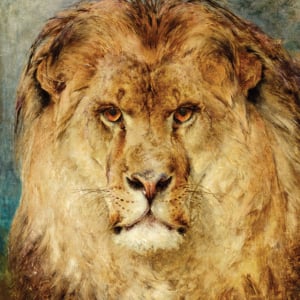
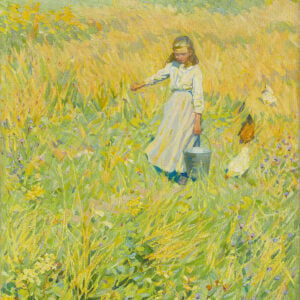
Thanks so much, very helpful!
Gid bless u, keep sharing your gift
R
Is this the Louise Terzia who worked at Arkansas Territorial Museum.?
This is SO helpful, Dan! This and your other recent lessons on how to develop an Artist’s eye to see LESS — to see the essentials of a beautiful painting without clutter, are exactly on target with what I need to be learning now. Thanks so much!
Spot on, that’s what I thought.
Thank u always wondered how to tackle a busy landscape. Aus. has some amazing landsccapes.
Thanks a lot.. Informative and interesting as always.
I am always tempted to paint all I see instead of showing what’s important and get the angles right. Thanks for reminding us of the rules.
Susanne
Susanne, I share the same problem with you. I really hope this will help us both.
Karen
Loved your outline of the process and what to look for in selecting a scene to paint. Thank you!
Thank you, Dan! Nice study!
Composition? Trees are approx same size,
Approx same color, approx same distance from edge, shadows on trees approx same size.
As Dan said, it’s a quick study to do further work from.
Nice idea to paint when ever you go out for a holiday.. thanks for sharing 👍
I have come across this problem and ditched the painting after i had finished it as it was terrible. This info is very handy . Thank you Dan.
Thank you, Dan. An artist friend has a trick to simplification: he studies the view he would like to paint for as long as he needs to. Then he turns his back on the scene and paints from memory…understanding that we tend to remember what impresses us most. He, too, is a fantastic artist and teacher.
Thanks for the information. I tend to make mine too busy. The picture is more interesting without everything you see..
Agreed, interesting to read the advice over and over again until it hits you and you get it!
Always appreciate reading and seeing the pictures and the results of Dan’s paintings.
“Towards the end of the painting, I actually needed to start working from memory because the shadows and colors had changed so significantly.”
Nature provides the inspiration and the artist provides the interpretation. Painting en plein air is a joy but it still comes down to the ‘mind’s eye’.
I like the simple beauty shown by the warmth of the sun on the trees and the cooler shadows on the water.
I like the simplicity of the painting. It subtly expresses the sun’s warmth on the trees and the cool shadows on the water.
Thanks Dan for your tips. Now I will be more knowlegable in tackling landscapes.
Mary Hall
Me, too, Mary! I’m learning a lot about simplifying a composition.
Thanks for all your helpful tips.
Brilliant Dan, well explained, much appreciated. Claire Gilchrist.
Many thanks for the tips you gave me, I already had an idea, when I am in holiday I can paint what i admire of the nature there. I am glad what you share with us.
Very good lesson for a beginner like me, thank you. Regards from Romania.
Thank you for demonstrating how to simplify scenes. I find your emails really useful. My paintings are improving as a result….
thanks, this is helpful.
what kind of equipment are you using? the pochade box looks nice, how do you like your new set up?
It is beautiful out the way it is now. I think taking a back to your studio and adding details would diminish it.
Nice Dan,
When do we see the finished article ??
Thanks, DaveM🇦🇺😎
Thanks David. You mean a larger version of the painting? Not sure if I will do one. We will see. Cheers, Dan
Thank you for your insight on minimizing the clutter in a scenery painting.
Thanks Dan. As usual you get my perceptive eye hovering over what you see and in this case I see what I don’t want to see – the leaves of the tree blotting out the lake . I want to see the lake. Question “ should the leaves be smaller, more varied , more colour variations with a play of light on them like a window opening up the view in front of you?”
Hi Tom. Probably – but I ran out of time as we had to checkout. So the leaves were a bit rushed. Thanks!
Dan
Thank you ad for the helpful tips, much appreciated
Conveyed good ideas, I like “simplify the “noise” down to a clear and concise subject to paint.”
Thanks.
Conveyed good ideas, I like transformation of clear and concise subject to paint without noise
Thanks.
Thank you to demonstrate the essence of a scenery out of the confusion and to bring out the part of memory to complete the painting.
Great lesson. May I ask two questions….How did you crop the photo….photoshop? Can you tells us more about your setup/pochade box?
Yup I use Photoshop, but there are some free alternatives if you don’t want to pay the monthly subscription. As for the painting setup, I might do a post on this within the next week for everyone.
Thanks!
Dan
I too would ike to know what M. James said. Photo? Pochade box name. Thanks. Your tips are wonderful.
Thanks Joyce – I will put together a post on this. It is one of the easels by New Wave, but more to come on that.
I had a similar problem using a photo I’d taken. Decided I wanted the big trees & depth, with the lake peekng through. What a job, but so happy with the result. And the friend who lived in the area wanted the pic.
Now that was extremely helpfull I always seem to put too much in my landscapes and get overwhelmed by the scenery thanks again Dan
That has simplified the process for me, thanks Dan, how good are the simple directions.
LA INCEPUT !cind am inceput sa pictez eram tentat asa acoar toata pimza si sa fi cit mai iniforma ce mare gresala acum privesc in spate si zibesc cit de gresit era !!
Thanks again..I always enjoy your emails.
Keri’s Kreations.
This is very helpful Dan. Thanks very much for sharing your techniques!! Take care, Joan
Thanks Dan.Very helpful tips of cutting noise. After all picture is that what artist sees with his beauty sense.
Thank you Dan.
You have reinforced the habit of not only looking but actually seeing. Look forward to your skilled teaching aids.
At the moment I have a blank sheet of white paper and am calling it SNOW. You inspire me to do better.
Love the tips on simplifying a complex scene. I struggle with this a lot. Well explained and simplified.
I guess I am an old modernist at heart so this resonated.